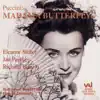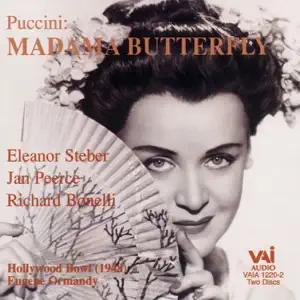


CIUDAD NATAL
New York, NY
NACIMIENTO
3 de junio de 1904
Acerca de Jan Peerce
Jan Peerce was known as "Toscanini's tenor," with his clean, incisive singing, exceptional breath support, and immediately distinctive timbre (though some considered his vibrato overly rattling). Peerce did not always record well in the studio, his voice often becoming harsh with a microphone and his technique losing some of the nuances contemporary critics praised in his stage singing. However, many of his live performances are now out of copyright, so provide a more accurate overview of his singing and style. While Peerce is often compared to his brother-in-law Richard Tucker (Peerce married Tucker's sister, Sara) -- both were born in New York, both were tenors, both studied to become cantors, and neither was a strong actor -- the similarities were largely superficial. There was a good deal of animosity between the two of them, Peerce feeling his contributions towards Tucker's career were ignored, Tucker feeling Peerce was jealous of his own accomplishments, which he felt were the greater.
Peerce grew up in a musical family, where his mother opened the house to dinner guests and eventually boarders to pay for his violin lessons. He and four friends formed a band, Pinky Pearl and His Society Dance Band (Peerce was born Jacob Pincus Perelmutter and nicknamed "Pinky" at home), which became quite successful. Peerce soon discovered that when he sang, that got as much or more attention than their playing. He favorably impressed Samuel Rothafel, a major Broadway impresario, and sang first on the Radio City Music Hall of the Air and then on stage at the opening of the physical Radio City Music Hall in 1932. He rapidly became one of the most popular radio performers in both popular and cantorial music, and in 1936, first sang "The Bluebird of Happiness," which became his signature tune (and the title of his 1973 autobiography). Arturo Toscanini heard him in a broadcast of Act I of Die Walküre (Peerce's only foray into Wagner, though Toscanini himself suggested that he sing Siegmund on stage), and hired him to sing the tenor role in his broadcast of Beethoven's Ninth, with the legendary NBC Symphony Orchestra. He became Toscanini's tenor of choice, and began to study opera with Giuseppe Borgatti. He made his opera debut at the Philadelphia Opera as the Duke in Rigoletto in 1938, and sang Alfredo in La Traviata in San Francisco, where Lawrence Tibbett pushed him into taking an extra solo bow. 1941 was also the year of his Met debut as Alfredo in La Traviata, and he sang each season with that company until 1968. In the late 1940s, he had a vocal crisis, but studied with Robert Weede (with whom he had sung at the Music Hall), regaining his earlier vocal placement and projection. He made regular tours with the Bach Aria Group throughout the 1950s and early 1960s. In 1956, he toured in the then-Soviet Union, singing a service in the Great Synagogue in Moscow, an overwhelming emotional experience for him, and one that he repeated in 1963. In 1971, he made his Broadway debut as Tevye in The Fiddler on the Roof. He retired from performing in 1982.
Peerce grew up in a musical family, where his mother opened the house to dinner guests and eventually boarders to pay for his violin lessons. He and four friends formed a band, Pinky Pearl and His Society Dance Band (Peerce was born Jacob Pincus Perelmutter and nicknamed "Pinky" at home), which became quite successful. Peerce soon discovered that when he sang, that got as much or more attention than their playing. He favorably impressed Samuel Rothafel, a major Broadway impresario, and sang first on the Radio City Music Hall of the Air and then on stage at the opening of the physical Radio City Music Hall in 1932. He rapidly became one of the most popular radio performers in both popular and cantorial music, and in 1936, first sang "The Bluebird of Happiness," which became his signature tune (and the title of his 1973 autobiography). Arturo Toscanini heard him in a broadcast of Act I of Die Walküre (Peerce's only foray into Wagner, though Toscanini himself suggested that he sing Siegmund on stage), and hired him to sing the tenor role in his broadcast of Beethoven's Ninth, with the legendary NBC Symphony Orchestra. He became Toscanini's tenor of choice, and began to study opera with Giuseppe Borgatti. He made his opera debut at the Philadelphia Opera as the Duke in Rigoletto in 1938, and sang Alfredo in La Traviata in San Francisco, where Lawrence Tibbett pushed him into taking an extra solo bow. 1941 was also the year of his Met debut as Alfredo in La Traviata, and he sang each season with that company until 1968. In the late 1940s, he had a vocal crisis, but studied with Robert Weede (with whom he had sung at the Music Hall), regaining his earlier vocal placement and projection. He made regular tours with the Bach Aria Group throughout the 1950s and early 1960s. In 1956, he toured in the then-Soviet Union, singing a service in the Great Synagogue in Moscow, an overwhelming emotional experience for him, and one that he repeated in 1963. In 1971, he made his Broadway debut as Tevye in The Fiddler on the Roof. He retired from performing in 1982.
Nosotros
Notas
